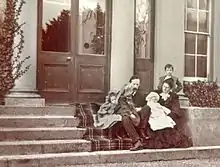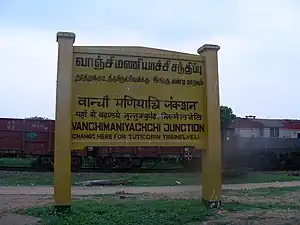Robert Ashe (civil servant)
Robert William d'Escourt Ashe (23 November 1872 – 17 June 1911) was the acting Collector and District magistrate of Tirunelveli district in Madras Presidency during the British Raj. Ashe had played a significant part in bringing about the closure of the Swadeshi Steam Navigation Company, started by V.O. Chidambaram Pillai to take on the British India Steam Navigation Company that had for long monopolised trade in the southern part of the Bay of Bengal. He had also been responsible for charging V.O.Chidambaram Pillai and a colleague, Subramanya Siva, for which they were convicted. On 17 June 1911 Ashe was assassinated by Vanchinathan at the Maniyachi railway junction, between Tirunelveli and Tuticorin.[1] After the shooting, Vanchinathan ran along the platform and took cover in the latrine. Some time later he was found dead, having shot himself in the mouth. Vanchi was accompanied by a youth named Sankara Krishna Aiyar who ran away, but was afterwards caught and convicted.[2] Ashe was the first and only colonial official to be assassinated in South India during the Indian independence movement.[3] The British government built a memorial for him at Tuticorin in 1913.[4] That memorial is currently in dilapidated condition.[5]


It is also claimed by certain Dalit out fits that Ash took action to ensure all people could bathe at the Courtallam waterfalls, which till then was exclusively reserved for the upper caste Indians and for bathing of idols of deities. This action opened up the waterfalls for the dalit people. Also he allowed to carry a lower caste women in the streets of Agrahara, place where upper caste lives, when she was sick and severely opposed caste discrimination in south districts of Madras presidency. This agitated the upper caste men and due to this Vanchinathan shot at Ashe. These claims are yet to be verified. In recent times, dalit organisations have been paying homage to Ashe on his birthday, by offering floral tributes to his memorial and his grave which is located at the English Church, opposite the St. John's College, Palamcottah.[6][7][8]
It is claimed that a low caste (harijan) woman who was screaming with labor pains had to be taken through the residence of brahmins (referred to as an Agraharam) to the hospital. Vanchinathan (a brahmin) prevented the woman screaming with labor pains to be taken through the Agraharam. When the news of this incident reached Ashe, he was enraged and beat Vanchinathan with his belt and safely escorted the woman through the Agraharam. Vanchinathan however killed Ashe later and committed suicide in a nearby railway latrine. However after independence Vanchinathan was portrayed as brave freedom fighter against the British by some.
Personal life
Ashe was a Protestant from Ireland. He had two sons and two daughters. One of his sons was killed in the Second World War while the other joined the Indian Army and served until 1947. His daughters died childless.[9]
References
- Vanchi Maniyachi
- Documents in the Life of Sri Aurobindo
- In The Foot Steps Of Ashe
- An Irish Link[Usurped!]
- Memorial to man shot by Vanchinathan lies dilapidated
- "Dalit outfit pays homage to Ashe". The Hindu. 18 June 2015. Retrieved 29 April 2020.
- "Hindu outfit opposes tribute to British Collector". Business Standard. Press Trust of India. 24 June 2015. Retrieved 29 April 2020.
- Arulolo, M (18 June 2019). "Bid to malign Vanchinathan kicks up row in Nellai dt". Self update. Retrieved 29 April 2020.
- Venkatachalapathy, A.R. (January 2010). "In search of Ashe". Economic and Political Weekly. 45 (2): 37–44. JSTOR 25663988.